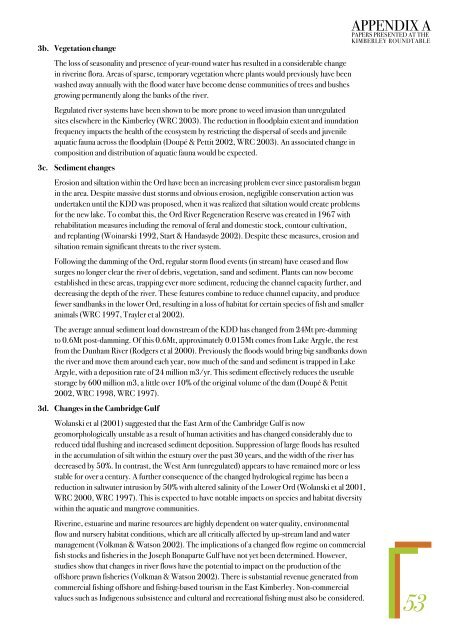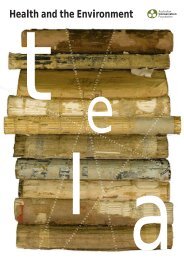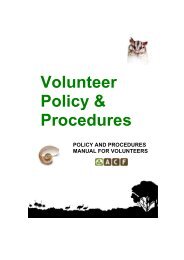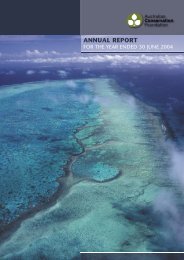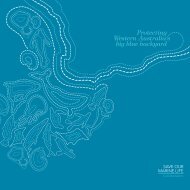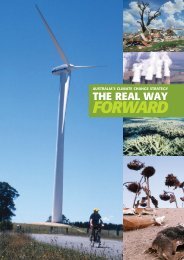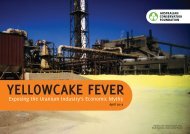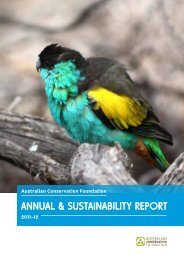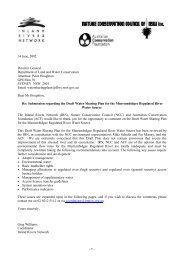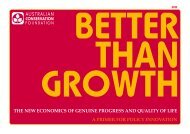Kimberley Appropriate Economics Interim Report - Australian ...
Kimberley Appropriate Economics Interim Report - Australian ...
Kimberley Appropriate Economics Interim Report - Australian ...
You also want an ePaper? Increase the reach of your titles
YUMPU automatically turns print PDFs into web optimized ePapers that Google loves.
3b. Vegetation change<br />
The loss of seasonality and presence of year-round water has resulted in a considerable change<br />
in riverine flora. Areas of sparse, temporary vegetation where plants would previously have been<br />
washed away annually with the flood water have become dense communities of trees and bushes<br />
growing permanently along the banks of the river.<br />
Regulated river systems have been shown to be more prone to weed invasion than unregulated<br />
sites elsewhere in the <strong>Kimberley</strong> (WRC 2003). The reduction in floodplain extent and inundation<br />
frequency impacts the health of the ecosystem by restricting the dispersal of seeds and juvenile<br />
aquatic fauna across the floodplain (Doupé & Pettit 2002, WRC 2003). An associated change in<br />
composition and distribution of aquatic fauna would be expected.<br />
3c. Sediment changes<br />
Erosion and siltation within the Ord have been an increasing problem ever since pastoralism began<br />
in the area. Despite massive dust storms and obvious erosion, negligible conservation action was<br />
undertaken until the KDD was proposed, when it was realized that siltation would create problems<br />
for the new lake. To combat this, the Ord River Regeneration Reserve was created in 1967 with<br />
rehabilitation measures including the removal of feral and domestic stock, contour cultivation,<br />
and replanting (Woinarski 1992, Start & Handasyde 2002). Despite these measures, erosion and<br />
siltation remain significant threats to the river system.<br />
Following the damming of the Ord, regular storm flood events (in stream) have ceased and flow<br />
surges no longer clear the river of debris, vegetation, sand and sediment. Plants can now become<br />
established in these areas, trapping ever more sediment, reducing the channel capacity further, and<br />
decreasing the depth of the river. These features combine to reduce channel capacity, and produce<br />
fewer sandbanks in the lower Ord, resulting in a loss of habitat for certain species of fish and smaller<br />
animals (WRC 1997, Trayler et al 2002).<br />
The average annual sediment load downstream of the KDD has changed from 24Mt pre-damming<br />
to 0.6Mt post-damming. Of this 0.6Mt, approximately 0.015Mt comes from Lake Argyle, the rest<br />
from the Dunham River (Rodgers et al 2000). Previously the floods would bring big sandbanks down<br />
the river and move them around each year, now much of the sand and sediment is trapped in Lake<br />
Argyle, with a deposition rate of 24 million m3/yr. This sediment effectively reduces the useable<br />
storage by 600 million m3, a little over 10% of the original volume of the dam (Doupé & Pettit<br />
2002, WRC 1998, WRC 1997).<br />
3d. Changes in the Cambridge Gulf<br />
Wolanski et al (2001) suggested that the East Arm of the Cambridge Gulf is now<br />
geomorphologically unstable as a result of human activities and has changed considerably due to<br />
reduced tidal flushing and increased sediment deposition. Suppression of large floods has resulted<br />
in the accumulation of silt within the estuary over the past 30 years, and the width of the river has<br />
decreased by 50%. In contrast, the West Arm (unregulated) appears to have remained more or less<br />
stable for over a century. A further consequence of the changed hydrological regime has been a<br />
reduction in saltwater intrusion by 50% with altered salinity of the Lower Ord (Wolanski et al 2001,<br />
WRC 2000, WRC 1997). This is expected to have notable impacts on species and habitat diversity<br />
within the aquatic and mangrove communities.<br />
Riverine, estuarine and marine resources are highly dependent on water quality, environmental<br />
flow and nursery habitat conditions, which are all critically affected by up-stream land and water<br />
management (Volkman & Watson 2002). The implications of a changed flow regime on commercial<br />
fish stocks and fisheries in the Joseph Bonaparte Gulf have not yet been determined. However,<br />
studies show that changes in river flows have the potential to impact on the production of the<br />
offshore prawn fisheries (Volkman & Watson 2002). There is substantial revenue generated from<br />
commercial fishing offshore and fishing-based tourism in the East <strong>Kimberley</strong>. Non-commercial<br />
values such as Indigenous subsistence and cultural and recreational fishing must also be considered.<br />
53


